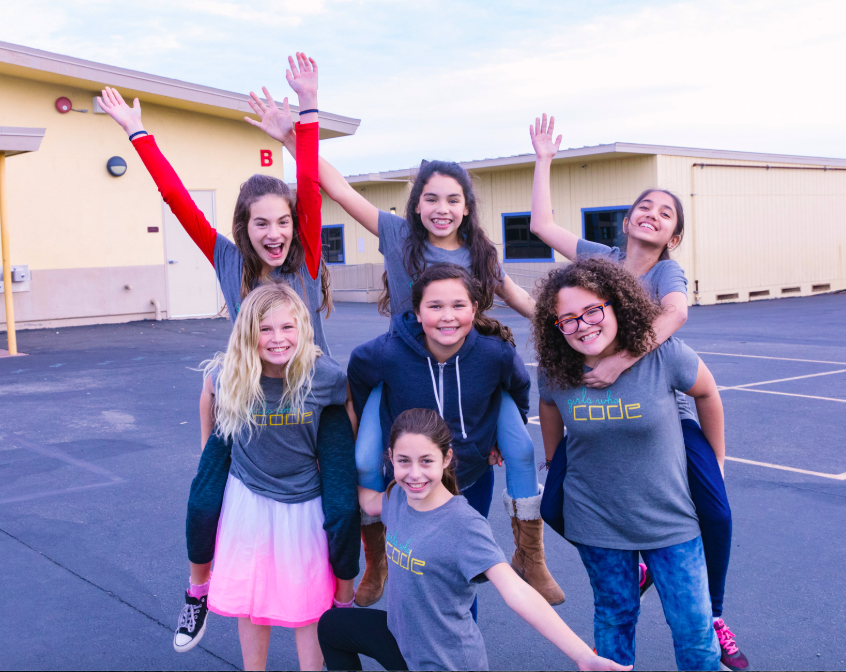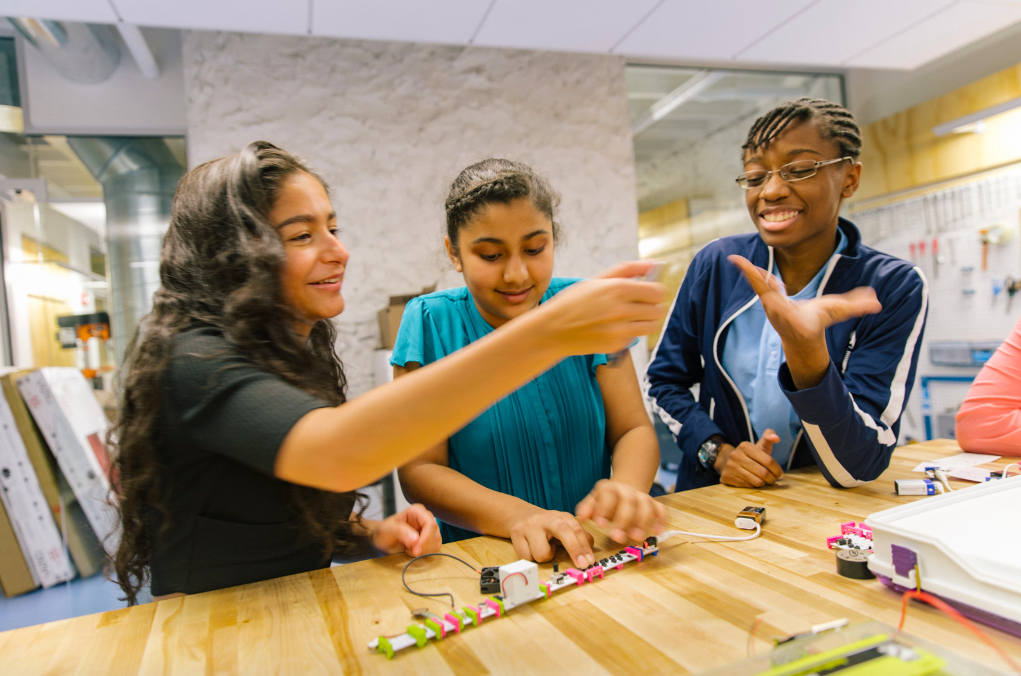By. Madeline Levine
“We have to teach [girls] to be brave in schools and early in their careers, when it has the most potential to impact their lives and the lives of others, and we have to show them that they will be loved and accepted not for being perfect but for being courageous.” – Reshma Saujani, CEO at Girls Who Code
At Girls Who Code, our mission is to end the gender gap in technology by inspiring, educating, and equipping girls with the computing skills needed to pursue 21st century opportunities. Our flagship Clubs program allows us to collaborate with educators and community members across the nation to get closer to meeting this goal every day.
Changing the World through Code
Coding is a great introduction to the world of computer science. Computer science is the study of computers and algorithmic processes, including their principles, their hardware and software designs, their implementation, and their impact on society. Coding is simply the process of using a programming language to get a computer to behave how you want it to.
For girls especially, coding provides an outlet for creativity and a way for them to make a positive impact on the world. With this in mind, we at Girls Who Code designed a curriculum based on the three pillars of our Educational Philosophy:
- The first pillar is More Than Code. We teach girls hard coding skills, but even more than that, we teach them life skills that they will need to succeed, such as confidence, resilience, project management, public speaking, and a growth mindset.
- The second pillar is Sisterhood, where we implement community-building activities to help girls know that they are not alone as they form a support system for one another.
- And lastly, our curriculum is based on hands-on, project-based learning that emphasizes Real-World Relevance and Community Impact. At the center of our curriculum is the Girls Who Code Impact Project, where girls work together in groups to use coding and their newly acquired life skills to create a project that addresses a real-world problem in the community that they care about. Past projects have ranged from building an app to remind you when to water your plants to developing a website about the water crisis in Flint, Michigan.
Our sixth- through twelfth-grade Clubs offer over 120 hours of flexible plug and play curriculum with beginner to advanced tutorials and lesson plans that are easy to pick up and run with. All lesson plans can be customized to meet the needs, skills, and interests of each Club, and all training, curriculum, and tutorials are housed on our online learning management system, Girls Who Code HQ.
At Girls Who Code, we strongly believe that “You cannot be what you cannot see.” Typical Club meetings start off with a Women in Tech Spotlight that showcases inspiring women who use coding in a variety of fields. This helps girls and young women start to see what is possible in the computer science space. We also find it to be a powerful opportunity to increase representation of women in our STEM curriculum.
Afterward, girls dive into self-guided coding tutorials which include Scratch, Python, JavaScript, Thunkable, and Swift. They then work on activities to build their culminating Girls Who Code Impact Project – such as learning how to do research or find their focus. Each meeting ends with a Stand Up, where the girls reflect upon their day to get feedback and look ahead to their next meeting.

Girls Decoding Climate Solutions – A Girls Who Code Impact Project
When Maryana, a parent in Cliffside Park, New Jersey, first heard about Girls Who Code, she was eager to get involved and bring this opportunity to her two daughters. Maryana immigrated to the United States in 1998 and worked for a fashion company. As time went on, she wanted to diversify her skill set and pursued a master’s degree that was focused on fashion and sustainability. As a role model for her daughters, Maryana wanted to find a way to combine her passions for promoting women’s entrepreneurship, education, and sustainability. This led her to start and facilitate a Girls Who Code Club at her local library.
Maryana worked with the library to promote the new Girls Who Code Club. Word spread fast among students who visited the library and the Club ended up with a core group of four to six girls, ranging in age from 11 to 16. Once the Club was formed, Maryana was eager to help the girls work together to create a meaningful Girls Who Code Impact Project. She encouraged the girls to identify topics on their own and they landed on the broad topic of sustainable solutions. Within this topic, each girl identified a focus that she found interesting and important for creating a more sustainable climate. For example, one picked food waste and how to deal with the amount of waste in this country, and another picked wind turbines and how we can reduce carbon dioxide by using renewable energy. For their culminating product, the girls decided to create a website that would serve as an easy one-stop-shop for raising awareness about how to reduce the negative effects of climate change. The website would also serve as a platform where they could highlight the different foci that they worked on as part of the project.
You can view the girls’ project here.
In addition to coding, Maryana provided the girls with lessons on essential skills they would need to be successful, such as presenting in front of an audience, breathing exercises to calm nerves, and practicing “the power pose.” For this Club, many of the girls liked to work independently, so teamwork was a challenge. Since the ultimate goal was to collectively design an impact project, the girls were encouraged to work together and develop their project management and teamwork skills. Once the website started to come together, the girls saw that they could individually contribute a small part to create something larger and more impactful than if they worked alone.
The lessons in coding and life skills developed through Maryana’s Girls Who Code Club have had an impact beyond the four walls of that local library. For the oldest Club member, the Girls Who Code Club led her to pursue an internship with Microsoft. She told Maryana that if she hadn’t come to the Girls Who Code Club, she would have likely never applied for this type of internship. At Microsoft, she worked with JavaScript and while it was extremely challenging, it made her appreciate what went into that type of work. After the internship ended, she signed up for another year with the Girls Who Code Club. Reflecting on her experience, she felt like she wanted to work in technology one day and be a coder so she could be involved in projects similar to those she worked on in the Club and at her internship.
Bring Girls Who Code to Your Community
Starting a Girls Who Code Club at your school or in your community is easy. All you need to get started is a space, a volunteer who can facilitate Club meetings, and access to the Internet and technology—Girls Who Code provides the rest! You can access the free Girls Who Code Clubs curriculum by applying at www.girlswhocode.com/clubs or emailing clubs@girlswhocode.com for more information.
Unable to meet in-person? Girls Who Code has a new home curriculum called Code at Home. Visit the website to learn more about this resource and download activities, such as creating binary bracelets.
Author Bio
Madeline Levine is the Senior Manager of Community Partnerships and Outreach at Girls Who Code, an international nonprofit that works to close the gender gap in technology and change the image of what a programmer looks like and does. As a passionate advocate of social justice, Levine works to foster strong community partnerships with school districts, library networks, and community-based organizations so that all girls have the opportunity to gain the confidence and skills they need to succeed in the 21st century.

